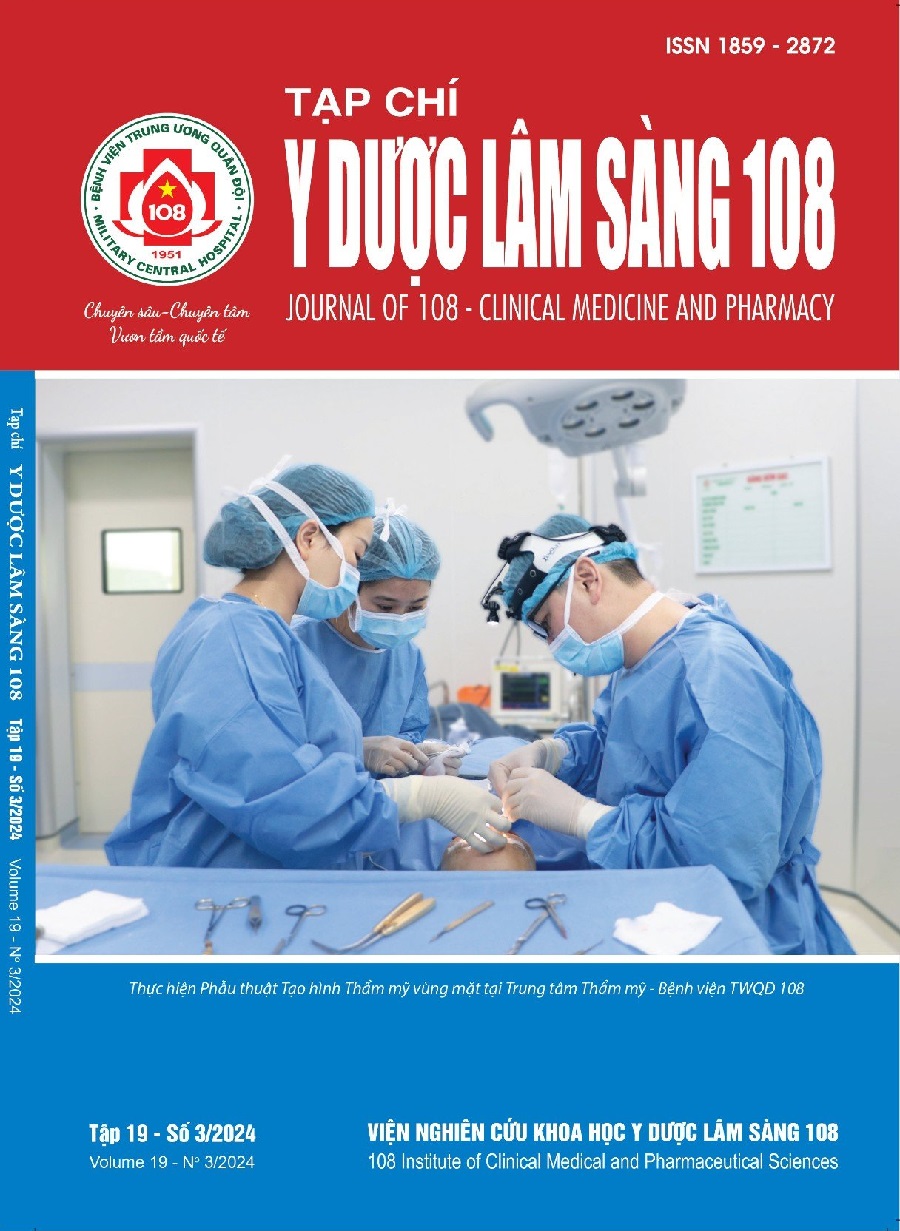The association between clinical features of fungal nail infection and causative fungal strains
Main Article Content
Keywords
Abstract
Objective: To investigate the association between clinical characteristics of fungal nail infection and causative fungal strains. Subject and method: A cross-sectional descriptive study was conducted on 110 patients diagnosed with fungal nail infection through fungal culture at the National Hospital of Dermatology and Venereology from August 2018 to July 2019. Result: Among 110 patients with onychomycosis, 22 patients (20%) had dermatophtye infections, 84 patients (76.4%) had yeast infections, and 4 patients (3.6%) had mold infections. Among the isolated fungal strains, C. krusei and C. albicans accounted for the highest proportion (40/110; 36.4%) and (27/110; 24.5%), respectively, followed by Trichopyton spp. (11/110; 10%). Perionychial inflammation was more common in patients infected with yeast than those infected with dermatophytes or and molds. The proportion of patients with proximal subungual onychomycosis infected with yeast was significantly higher than those infected with dermatophytes or molds (p=0.001). The proportion of superficial onychomycosis infected with dermatophytes was significantly higher than those infected with yeast or molds (p<0.0001). There was no difference in the subjective symptoms or location of nail infection (fingers or toes) among three causative fungal groups. Conclusion: The proportion of onychomycois patients infected with yeast (76.4%) was higher than those infected with dermatophytes and molds. Patients infected with yeast are more likely to have perionychial inflammation and proximal subungual onychomycosis than those infected with dermatophytes or molds. Superficial onychomycosis were more common in patients infected with dermatophytes than those infected with yeast or molds.
Article Details
References
2. Phạm Văn Hiển (2010) Các bệnh nấm nông thường gặp. Da liễu học. Nhà xuất bản Giáo dục Việt Nam, tr. 99-101.
3. Nguyễn Thị Đào, Nguyễn Đức Thảo, Tăng Minh (1978) Bóc tách móng bằng Ure-plaste kết hợp với Griseofulvine trong điều trị nấm móng. Nội san da liễu, Tổng hội Y học Việt Nam. 89(4), tr. 45-50.
4. Nguyễn Thị Đào (1972) Ảnh hưởng pH da trong phát sinh, phát triển bệnh nấm. Nội san Da liễu, Tổng hội Y học Việt Nam.
5. Roberts DT, Evans EG, Allen BR (1998) Nail structure, yeast, candida infection. Fungal infection of the nail, M. Mosby - Wolfe, U.K: 28-68.
6. Faergemann J and Baran R (2003) Epidemiology, clinical presentation and diagnosis of onychomycosis. Br J Dermatol 149(65): 1-4.
7. Võ Đông Xuân (2013) Nghiên cứu đặc điểm lâm sàng, một số yếu tố liên quan và giá trị của các xét nghiệm trực tiếp phát hiện nấm móng. Luận án. Trường Đại học Y Hà Nội.
8. Gupta AK, Jain HC, Lynde CW, Macdonald P, Cooper EA, Summerbell RC (2000) Prevalence and epidemiology of onychomycosis in patients visiting physicians’ offices: A multicenter Canadian survey of 15,000 patients. J Am Acad Dermatol 43(2-1): 244-248. doi:10.1067/mjd.2000.104794.
9. Agarwalla, Agrawal S and Khanal B (2006) Onychomycosis in eastern Nepal. Nepal Med Coll J 8(4): 215-219.
10. Diongue K, Ndiaye M, Seck MC, Diallo MA, Badiane AS, Ndiaye D (2017) Onychomycosis caused by Fusarium spp. In Dakar, Senegal: epidemiological, clinical, and mycological study. Dermatology Research and Practice 2017:1268130. doi: 10.1155/2017/1268130.
11. Garg A, Venkatesh V, Singh M et al (2004) Onychomycosis in central India: A clinicoetiologic correlation. Int J Dermatol 43(7): 498-502.
12. Aghamirian R and Ghiasian SA (2010) Onychomycosis in Iran: Epidemiology, causative agents and clinical features. Nihon Ishinkin Gakkai Zasshi 51(1): 23-29.
13. Kim DM, Suh MK and Ha GY (2013) Onychomycosis in children: an experience of 59 cases. Ann Dermatol 25(3): 327-334.
 ISSN: 1859 - 2872
ISSN: 1859 - 2872
